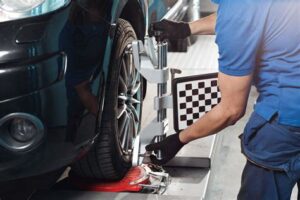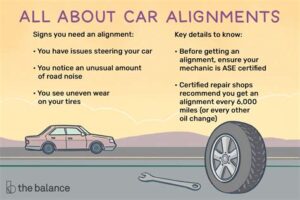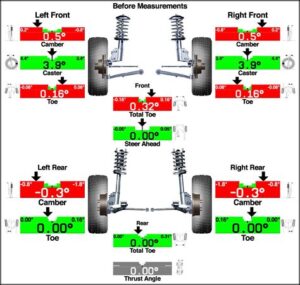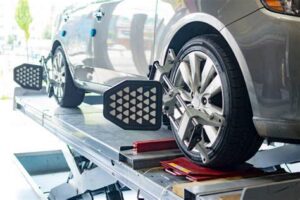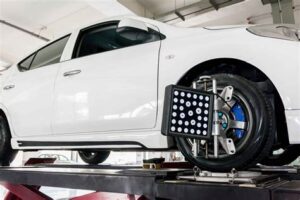How Do You Know Your Car Needs an Alignment?
Driving a vehicle that maintains proper alignment is crucial for ensuring safety, performance, and longevity. Over time, various factors such as potholes, curbs, and general wear can disrupt your car’s alignment, leading to uneven tire wear and decreased handling. But how can you tell when your car needs an alignment? This article delves into the signs indicating misalignment, the effects it can have on your vehicle’s overall performance, and how to assess alignment at home. Additionally, we’ll explore when to seek professional help and the significant benefits of regular wheel alignment. Understanding these aspects will not only enhance your driving experience but also extend the life of your vehicle. Read on to discover how to keep your ride smooth and safe!
Signs Indicating How Do You Know Your Car Needs An Alignment
Detecting whether your car is in need of alignment can be crucial for maintaining both safety and efficiency while driving. Here are some clear signs that indicate how do you know your car needs an alignment:
- Uneven Tire Wear: If you observe that your tires are wearing down unevenly, it’s a strong indicator that your vehicle might be misaligned. This can lead to premature tire replacement and increased costs.
- Pulling to One Side: If you find yourself constantly adjusting the steering wheel to stay in a straight line, it’s a sign that your car may need an alignment. This pulling can be more prominent on highways.
- Steering Wheel Vibration or Off-Center: A vibrating steering wheel or one that’s off-center, even when your car is going straight, suggests alignment issues. Your steering wheel should be perfectly straight when driving on a level road.
- Unusual Noises: Hearing sounds, such as squeaking or grinding when turning, can indicate problems with your suspension or alignment. It’s essential to get these checked out.
- Changes in Handling: If your car feels less responsive or more difficult to handle, it may be due to poor alignment affecting your steering and control.
Being aware of these signs can help you proactively address the need for alignment, ensuring a safer driving experience and preserving the longevity of your vehicle.
Effects Of Misalignment On Your Vehicle’s Performance
When your vehicle experiences misalignment, various performance issues can arise, affecting not only handling but also safety and longevity. Here are some key effects of misalignment:
- Uneven Tire Wear: Misalignment can cause your tires to wear unevenly, leading to a shorter lifespan and the need for early replacements.
- Poor Handling: A misaligned vehicle can drift or pull to one side, making it difficult to steer and control, potentially leading to dangerous situations.
- Reduced Fuel Efficiency: When your wheels are misaligned, your engine has to work harder to maintain speed, resulting in increased fuel consumption.
- Increased Stress on Suspension Components: Misalignment can place extra strain on your vehicle’s suspension system, leading to premature wear and potential breakdowns.
- Enhanced Risk of Accidents: With compromised handling and control, the likelihood of accidents increases, particularly in adverse weather conditions.
Regular alignment checks are crucial to avoid these issues. If you find yourself asking how do you know your car needs an alignment, referring to the signs you’ve already noted can help in timely intervention.
Steps To Check Your Car’s Alignment At Home
Checking your car’s alignment at home can save you time and money. Here are some simple steps to follow:
- Inspect Your Tires: Start by examining your tires for uneven wear. If one side is more worn than the other, it may be a sign of misalignment.
- Check Your Tire Pressure: Ensure that all tires are properly inflated according to the manufacturer’s specifications. Incorrect tire pressure can affect alignment readings.
- Perform the Straight and Level Test: Find a flat, level surface and drive your car straight (without steering). If you notice the steering wheel pulling to one side, this may indicate a misalignment.
- Measure Toe Alignment: Use a measuring tape to check the distance between the front and rear of the front tires. The distance should be equal. If not, adjustments may be necessary.
- Use a DIY Alignment Tool: You can create a simple alignment tool with a string and a level. Attach the string to the rear tires and measure the distance to the front tires. This will help you assess any discrepancies.
- Check Steering Wheel Position: When driving straight, your steering wheel should be centered. If it’s off-center while driving, it’s another indication of alignment issues.
While these steps can help you gauge your car’s alignment, how do you know if professional help is needed? If you notice significant issues during your checks, it may be best to visit a mechanic.
Professional Alignment Services: When And Why To Seek Help
Understanding how do you know when to seek professional alignment services is essential for maintaining your vehicle’s performance. While there are numerous signs that indicate your car may need an alignment, some situations warrant immediate professional attention. Here are key factors that can help you determine when it’s time to consult an expert:
- Severe Handling Issues: If you experience significant steering difficulties, like pulling to one side or excessive vibration, it’s critical to visit a professional as soon as possible.
- Uneven Tire Wear: An alignment check is necessary if you notice that your tires are wearing unevenly. This can lead to costly replacements if left unaddressed.
- After Suspension Repairs: If you’ve recently had any suspension components repaired or replaced, a professional alignment is essential to ensure everything is functioning correctly.
- Following an Accident: Even minor accidents can affect your vehicle’s alignment. If your car has been involved in a collision, it’s advisable to get an alignment check.
- Regular Maintenance Schedule: It’s ideal to include alignment checks in your routine vehicle maintenance. Some manufacturers recommend alignment inspections at specific intervals.
Seeking professional alignment services not only ensures proper alignment but also enhances the overall safety and efficiency of your vehicle. Mechanics use specialized equipment that cannot be replicated at home, ensuring that every angle is adjusted precisely to manufacturer specifications.
Paying attention to these signs can help you answer the question of how do you know your car needs an alignment, preventing further damage and ensuring a smooth driving experience.
Benefits Of Regular Wheel Alignment For Vehicle Longevity
Maintaining proper wheel alignment is crucial for ensuring the longevity of your vehicle. Regular wheel alignments yield several significant benefits that not only enhance your driving experience but also protect your investment. Here are some key advantages:
- Improved Tire Life: One of the most immediate benefits of regular wheel alignment is the extended life of your tires. When your wheels are aligned correctly, they wear evenly, which can help you avoid premature tire replacements due to uneven tread wear.
- Enhanced Fuel Efficiency: Proper wheel alignment minimizes rolling resistance, consequently improving your vehicle’s fuel efficiency. A well-aligned vehicle requires less effort to move, allowing you to save on fueling costs.
- Better Handling and Safety: A precise alignment helps your vehicle handle better on the road. This is especially important in emergency situations. When your wheels are aligned correctly, your car tracks straight and responds accurately to steering inputs.
- Reduced Stress on Vehicle Components: Regular alignment reduces undue stress on your suspension and steering components. This can prevent costly repairs down the line and helps maintain overall vehicle performance.
- Comfortable Ride: Misalignment can lead to vibrations and pulling to one side while driving. Keeping your wheels aligned ensures a smoother, more comfortable ride, enhancing your overall driving experience.
By understanding how do wheel alignment benefits your vehicle, you can make informed decisions regarding maintenance schedules. Regularly checking and adjusting your wheel alignment not only enhances performance but also contributes significantly to the longevity of your vehicle.
Frequently Asked Questions
What are the signs that indicate my car needs an alignment?
Common signs include uneven tire wear, steering wheel off-center, pulling to one side while driving, and a vibrating steering wheel.
How often should I check if my car needs an alignment?
It’s recommended to have your alignment checked every 6,000 miles or at each oil change, or sooner if you notice any symptoms.
Can misalignment affect my vehicle’s fuel efficiency?
Yes, misalignment can lead to increased tire wear, causing your vehicle to work harder and ultimately decreasing fuel efficiency.
Is it safe to drive a car that needs an alignment?
Driving a misaligned car can be unsafe as it may lead to loss of control, increased tire wear, and other mechanical issues.
What causes a car to become misaligned?
Common causes include hitting potholes, curbs, or speed bumps, as well as wear and tear on suspension components.
How long does an alignment service take?
Typically, an alignment service can take anywhere from 30 minutes to an hour, depending on the technician’s workload and the condition of the vehicle.
Can I perform an alignment myself, or should I take it to a professional?
While there are DIY alignment kits available, it’s generally recommended to have alignments performed by a professional for accuracy and safety.

